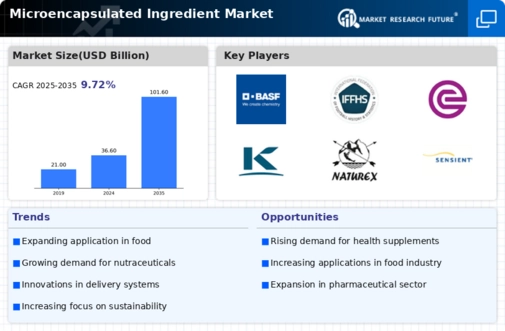Market Growth Projections
The Global Microencapsulated Ingredient Market Industry is poised for substantial growth, with projections indicating a compound annual growth rate (CAGR) of 9.72% from 2025 to 2035. This growth trajectory reflects the increasing adoption of microencapsulated ingredients across diverse sectors, including food, pharmaceuticals, and cosmetics. The market is expected to expand from 36.6 USD Billion in 2024 to 101.6 USD Billion by 2035, driven by factors such as technological advancements, rising consumer demand for functional products, and regulatory support for quality and safety.
Rising Demand for Functional Foods
The Global Microencapsulated Ingredient Market Industry experiences a notable surge in demand for functional foods, driven by increasing consumer awareness regarding health and wellness. As consumers seek products that offer additional health benefits, microencapsulated ingredients provide a viable solution by enhancing bioavailability and stability. This trend is reflected in the projected market growth, with the industry expected to reach 36.6 USD Billion in 2024. The incorporation of microencapsulated vitamins, minerals, and probiotics into food products aligns with the growing preference for functional nutrition, thereby propelling the market forward.
Growing Applications in Pharmaceuticals
The pharmaceutical sector increasingly adopts microencapsulated ingredients, which serves as a key driver for the Global Microencapsulated Ingredient Market Industry. Microencapsulation enhances drug delivery systems by improving the solubility and bioavailability of active pharmaceutical ingredients. This trend is particularly evident in the development of controlled-release formulations, which provide therapeutic benefits over extended periods. As the pharmaceutical industry continues to innovate, the demand for microencapsulated ingredients is expected to rise, contributing to the market's anticipated growth to 101.6 USD Billion by 2035.
Consumer Preference for Natural Ingredients
A discernible shift towards natural and clean-label products is shaping the Global Microencapsulated Ingredient Market Industry. Consumers increasingly favor products that contain natural ingredients, prompting manufacturers to explore microencapsulation as a means to protect sensitive compounds while maintaining their natural integrity. This trend is particularly relevant in the food and beverage sector, where the demand for organic and non-GMO products is on the rise. By utilizing microencapsulation, companies can enhance the stability and shelf life of natural ingredients, thereby catering to the evolving preferences of health-conscious consumers.
Regulatory Support for Food Safety and Quality
Regulatory frameworks promoting food safety and quality standards significantly impact the Global Microencapsulated Ingredient Market Industry. Governments worldwide are implementing stringent regulations to ensure the safety and efficacy of food products, which encourages the use of microencapsulated ingredients. These regulations often require manufacturers to adopt advanced technologies that enhance product quality and safety. As a result, the market is likely to benefit from increased compliance with food safety standards, fostering growth opportunities for microencapsulated ingredients across various applications.
Technological Advancements in Encapsulation Techniques
Innovations in encapsulation technologies significantly influence the Global Microencapsulated Ingredient Market Industry. Techniques such as spray drying, coacervation, and liposome encapsulation enhance the efficiency and effectiveness of microencapsulation processes. These advancements not only improve the stability and release profiles of active ingredients but also expand their applications across various sectors, including food, pharmaceuticals, and cosmetics. The continuous evolution of these technologies is likely to contribute to the market's growth trajectory, as manufacturers increasingly adopt advanced methods to meet consumer demands for high-quality microencapsulated products.




















